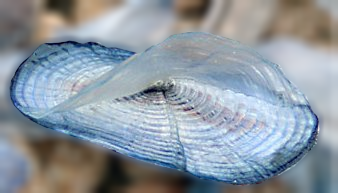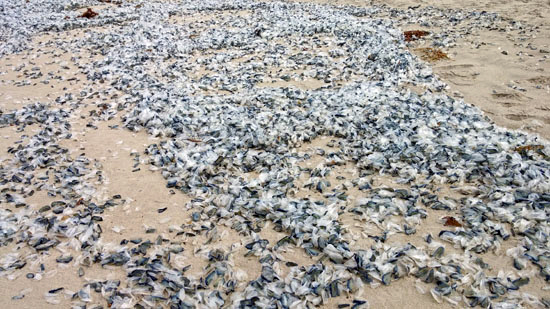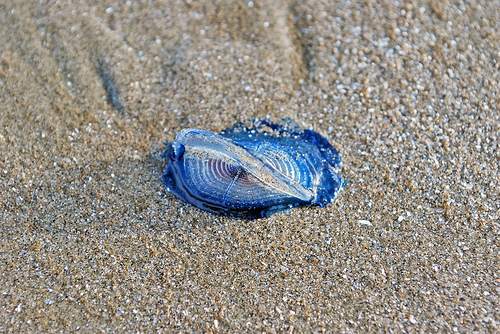These jellyfish have no means of locomotion apart from their sails, so they are at the mercy of prevailing winds and, consequently, subject to mass-strandings on beaches throughout the world. For example, most years in the spring, there is a mass stranding that occurs along the West Coast of North America, from British Columbia to California, beginning in the north and moving south over several weeks’ time. In some years, so many animals are left at the tide line by receding waves, that the line of dying (and subsequently rotting) animals may be many centimeters deep, along hundreds of kilometers of beaches (Wikipedia: Velella).
Velella is a cosmopolitan genus of free-floating hydrozoans that live on the surface of the open ocean. There is only one known species, Velella velella, in the genus. Velella velella is commonly known by the names sea raft, by-the-wind sailor, purple sail, little sail, or simply Velella. These small cnidarians are part of a specialised ocean surface community that includes the better-known cnidarian siphonophore, the Portuguese man o’ war. Specialized predatory gastropod mollusks prey on these cnidarians. Such predators include nudibranchs (sea slugs) in the genus Glaucus and purple snails in the genus Janthina (Ibid.).
Each apparent individual Velella velella is in fact a hydroid colony, and most are less than about 7 cm long. They are usually deep blue in color, but their most obvious feature is a small stiff sail that catches the wind and propels them over the surface of the sea. Under certain wind conditions, they may be stranded by the thousand on beaches (Ibid.).
Like other Cnidaria, Velella velella are carnivorous. They catch their prey, generally plankton, by means of tentacles that hang down in the water and bear cnidocysts (also called nematocysts). Though the toxins in their nematocysts are effective against their prey, V. velella is essentially harmless to humans. While cnidarians all possess nematocysts, in some species the nematocysts and toxins therein are more powerful than other species. V. velella has nematocysts that are relatively benign to humans, although each person may respond differently to contact with the nematocyst toxin. It is wise to avoid touching one’s face or eyes after handling V. velella, and itching may develop on parts of the skin that have been exposed to V. velella nematocysts (Ibid.).
Editor’s note: Many thanks to Academic Personnel and Space Management Analyst Bernadette Weinberg for bringing this material to our attention. For more about jellyfish invasions and their consequences, see the May 6, 2013 article “Jellyfish: If we can’t beat ‘em, why not eat ‘em?”




